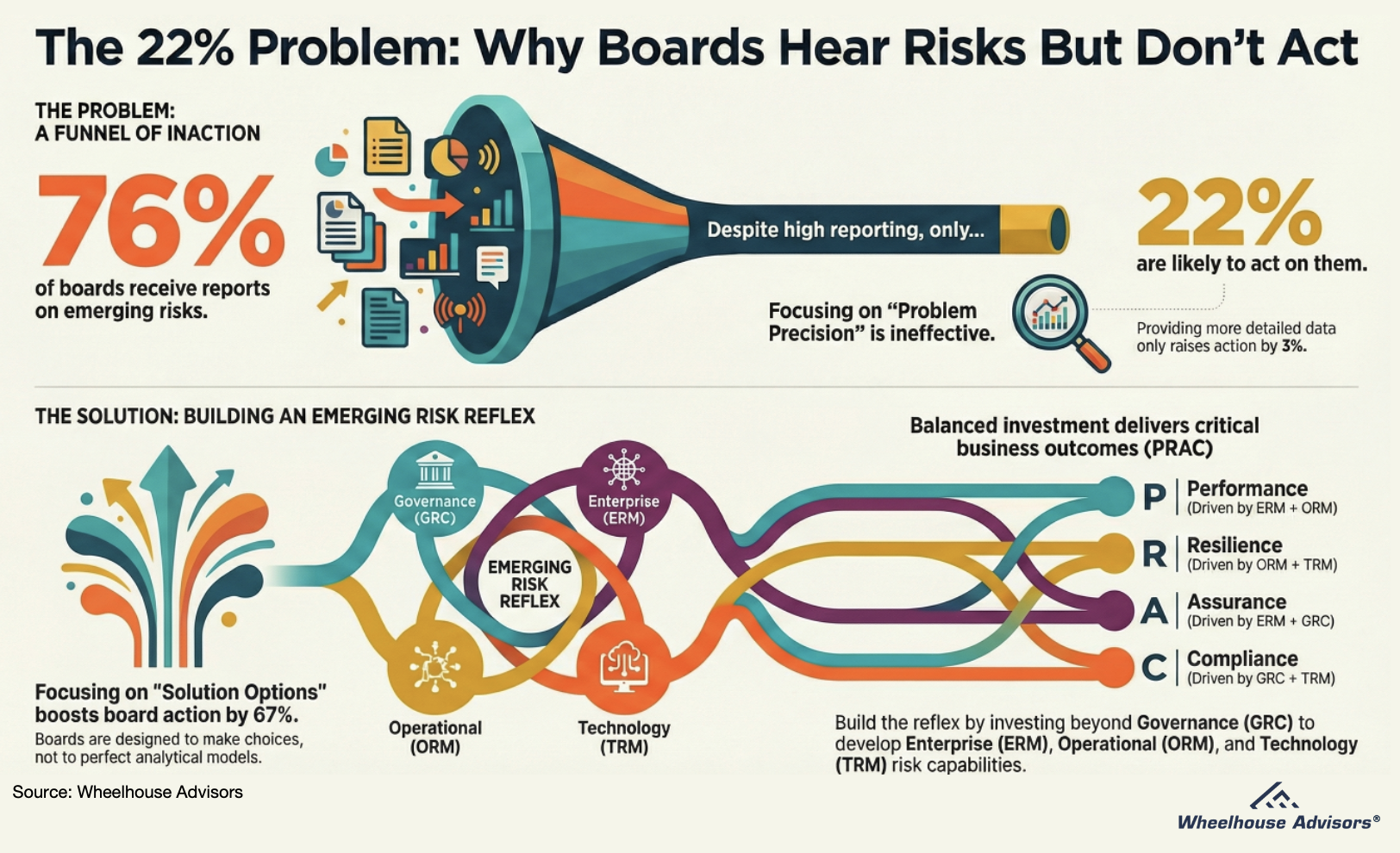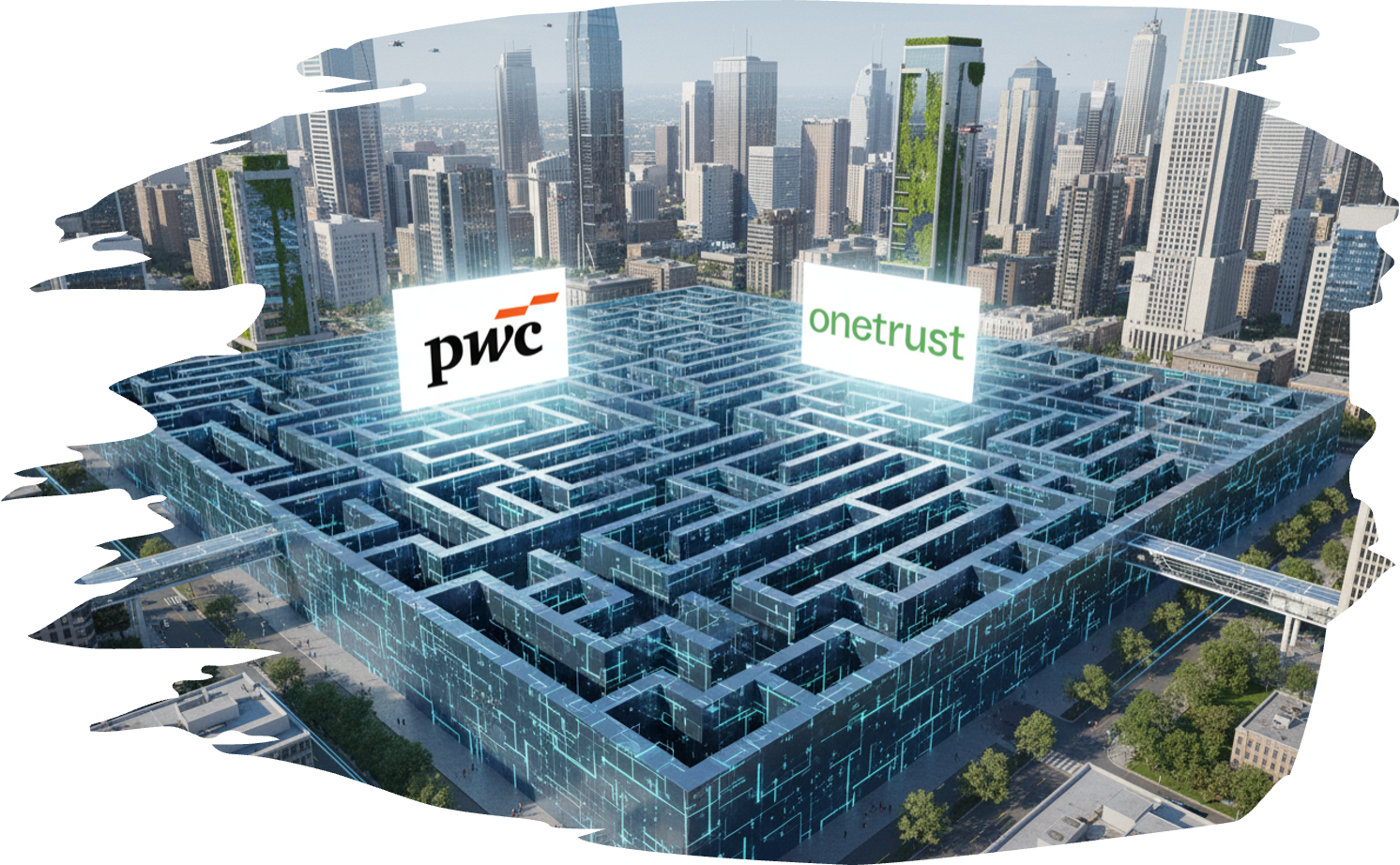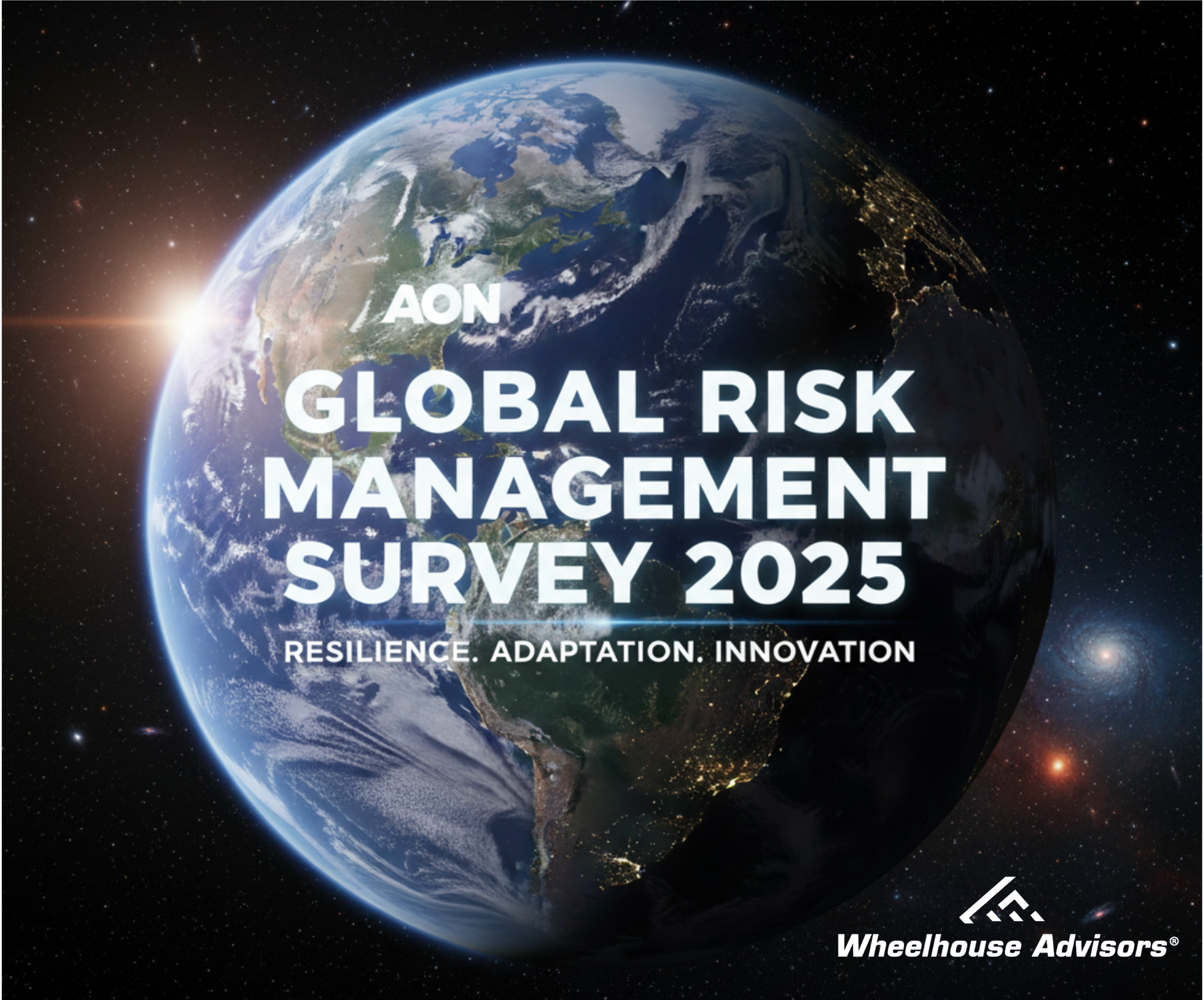
The RTJ Bridge is the new premium version of The RiskTech Journal, delivering fast-moving, strategically relevant insights for risk leaders navigating today’s digital business landscape.
Designed as the link between editorial commentary and in-depth research, The RTJ Bridge offers exclusive access to:
High-frequency insight notes on market shifts, regulatory signals, and emerging technologies
Executive briefings and editorial series including “The Risk Ignored”
Strategic previews of IRM Navigator™ research, including upcoming Risk Landscape Reports
Whether you're monitoring vendor moves, tracking governance shifts, or preparing for regulatory disruption, The RTJ Bridge equips you with actionable foresight.
The RTJ Bridge - The Premium Version of The RiskTech Journal
Subscribe to get access now
The RTJ Bridge Subscription is a premier resource for executives and professionals focused on the intersection of risk management and technology. It provides subscribers with access to a curated collection of articles and expert insights designed to enhance risk management strategies through technological innovation. With its online format, The RTJ Bridge offers flexible access to critical information, helping leaders make informed decisions and stay competitive.

What the EU’s Updated Sustainability Rules Mean for U.S. Companies
The European Union has reached a provisional political agreement to revise its sustainability reporting and supply-chain due-diligence framework. The agreement, completed under the Omnibus I package, significantly narrows the scope of both the Corporate Sustainability Reporting Directive (CSRD) and the Corporate Sustainability Due Diligence Directive (CSDDD). The revised thresholds remove obligations for many companies, particularly those headquartered outside the EU with smaller regional footprints.
However, the strategic direction remains unchanged. Large U.S. multinationals with material operations, revenue, or supply-chain exposure in the EU will continue to face substantial reporting, due-diligence, and legal liability requirements. The EU is signaling a long-term expectation that sustainability, human rights, and environmental risk management form an integrated component of corporate governance and enterprise risk programs.
For U.S. companies, the reduced scope is not an exemption from responsibility. It is an opportunity to mature risk capabilities, unify global sustainability reporting, and strengthen supply-chain due diligence before enforcement and investor scrutiny intensify.

Does GRC Need Finishing School? The IRM Navigator™ View on Forrester’s GRC ‘Grad School’ Story
Forrester's recent blog “GRC Platforms Enter Their Grad School Era” contains a notable admission. The analysts describe GRC as "old enough to be in grad school," yet still struggling to prove it can act as the workhorse technology for modern risk professionals. After roughly 20 years of formal coverage, the firm suggests that GRC is not yet fully ready for the “real world” of risk and now needs a kind of graduate-level evolution, built on continuous controls monitoring, quantification, and AI. This observation raises an obvious question. Does GRC really need finishing school after decades of market evolution, or have we been asking the category to do the wrong job?

The 22 Percent Problem: Why Boards Hear the Risks but Still Do Nothing
If your board is hearing more emerging risks than ever and still doing almost nothing, you are not alone. Gartner data shows seventy-six percent of boards receive emerging risk reports, but only twenty-two percent are likely to act on what they hear. This IRM Navigator™ research note explains why that gap exists and how GRC-centric investment quietly builds oversight while starving your organization of reflex. If you are tired of “noted” being the only outcome, this is the playbook for turning emerging risk insight into action.

The Static Quadrant: Why GRC Stopped Moving
The “2025 Gartner® Magic Quadrant™ for Governance, Risk and Compliance (GRC) Tools, Assurance Leaders” offers more than an update on vendor positioning. It captures a defining moment in the evolution of enterprise risk management technology. For the first time since Gartner began coverage of this market in 2008, the Visionaries quadrant is completely empty.
This absence is not an error or a symptom of decline. It is a reflection of structural maturity and the point at which a technology category stops expanding outward and begins to integrate inward. The GRC segment has stabilized around its purpose: to deliver reliable assurance, compliance automation, and control verification at scale.
This research note is a follow-up to the recent RiskTech Journal article, GRC Without Visionaries: What the 2025 Gartner® Magic Quadrant™ Reveals About the Future of Risk. It further examines why the quadrant has gone static, why that matters, and how the integration of GRC within the broader Integrated Risk Management (IRM) model marks a necessary and healthy progression. It concludes that the current stillness in GRC represents not the end of innovation, but the beginning of Assurance Intelligence. It is the fusion of compliance evidence, operational data, and AI-enabled assurance that will define risk management by 2032.

Agentic AI Moves From Hype to Operating Model: What Risk Leaders Must Do Now
EY’s newest global insight, “What Risk Leaders Need to Do Now About Agentic AI,” sets a clear challenge: organizations that treat agentic AI as another productivity initiative risk amplifying exposure, not mitigating it. The report argues that risk functions must now move beyond experimentation and build an enterprise operating model where autonomous and semi-autonomous agents can act safely, transparently, and in alignment with strategy.
This message reinforces a structural shift already underway in Integrated Risk Management (IRM). Wheelhouse Advisors’ Autonomous IRM model defines how these agentic systems should operate—not as isolated bots or chat interfaces, but as integrated decision engines that connect strategic intent, operational execution, and assurance validation.

Workiva’s Q3 2025 Results Signal the Rise of “Assured Data Platforms” in the IRM Market
Workiva’s Q3 2025 results represent more than a financial beat—they reveal a strategic inflection point for the Integrated Risk Management (IRM) market. The company delivered total revenue of $224 million, up 21% year over year, with subscription and support revenue growing 23%. Its non-GAAP operating margin expanded to 12.7%, nearly tripling from the prior year. Just as significant, customers with annual contract value (ACV) above $500,000 rose 42%, confirming enterprise-scale adoption of Workiva’s unified disclosure and assurance platform.
This growth underscores a broader market movement toward “assured data platforms”—solutions that unify financial, sustainability, and risk reporting within one governed architecture. As ESG regulation, audit digitization, and AI assurance converge, Workiva’s performance signals what IRM leaders should expect across the next phase of market maturity.

ServiceNow Q3 2025 Through an IRM Market Lens
ServiceNow’s Q3 2025 performance is a clear demand signal for platform-centric Integrated Risk Management. The company reported subscription revenue of 3.299 billion dollars, up 21.5 percent year over year, with strong large-deal activity and a raised full-year subscription outlook. These results, combined with the AI Control Tower launch and continued Now Assist upgrades, indicate that buyers are consolidating GRC, technology risk, and assurance workflows on a single operating platform that can also govern AI models, agents, and evidence. This is an accelerant for IRM programs that seek unified taxonomies, end-to-end traceability, and continuous control monitoring across ERM, ORM, TRM, and compliance functions.

Reinventing Risk Management Through Integrated Risk, A PwC and OneTrust Perspective
PwC and OneTrust have published a concise eBook that advocates for a unified, digital operating model for risk, and positions their alliance to deliver it. The document highlights pressure on risk and compliance teams, presents recent PwC survey signals on funding and prioritization gaps, and outlines an “IRM ecosystem mindset” anchored in OneTrust’s modular platform and PwC’s implementation services.

IRM OnWatch: Acquisitions and Partnerships Signal Further Movement Away from Stand-alone GRC to Unified IRM
This past week, the IRM market took a decisive step toward operationalizing AI oversight at scale. AuditBoard moved first with a definitive agreement to acquire FairNow, a purpose-built AI governance platform, and expanded its alliance with EY US to pair platform capabilities with consulting delivery. In parallel, boardroom and sustainability workflows tightened through a new Diligent–Persefoni partnership, and specialized compliance players announced alliances that round out the IRM ecosystem. The signal is clear: buyer demand is shifting from point capabilities to unified operating models that align platforms, data, and services across Performance, Resilience, Assurance, and Compliance.

Agentic Operational Risk: How AI Is Reshaping Control, Performance, and Resilience
Operational risk management is evolving from reactive oversight to intelligent orchestration. Agentic AI, systems that can plan, tool, and act with bounded autonomy, is at the center of this shift. These agents compress cycle times, expand control coverage, and deliver evidence with audit grade traceability. Within the IRM Navigator™ Model, they strengthen the connection between Performance and Resilience, the two objectives where ORM delivers the most tangible value.

EY’s Boomi Alliance Accelerates IRM+ into the Autonomous IRM Era
EY’s new alliance makes Boomi the preferred way to connect the many systems IRM+ depends on, move and manage the data they generate, and orchestrate AI (including AI agents) around IRM+ workflows. IRM+ itself continues to be anchored on ServiceNow for risk workflows; Boomi primarily strengthens the integration, data, and AI layers around it.

Bridging the Divide: How ServiceNow’s AI Experience Could Unify TRM and IRM
ServiceNow’s latest innovation, AI Experience, introduces a unified conversational interface that could redefine how organizations manage risk. Far from being another “AI assistant,” this platform-level integration embeds natural language and multimodal intelligence across workflows, connecting Technology Risk Management (TRM) with Integrated Risk Management (IRM) in ways that make risk management feel less like a process and more like a conversation. This commentary explores how AI Experience extends ServiceNow’s TRM and IRM capabilities, why it represents a major shift toward unified risk intelligence, and how it aligns with the Performance, Resilience, Assurance, and Compliance (PRAC) objectives of the IRM Navigator™ Model.

Aon GRMS Survey 2025: Integrated Risk Management Moves From Slogan to System
Aon’s 2025 Global Risk Management Survey frames the environment as a system of overlapping risks that cannot be managed effectively in silos. The “Top 10 Global Risks” chapter states that organizations that adopt a proactive, integrated approach can turn complexity into opportunity. This aligns directly with the IRM Navigator™Model and its PRAC objectives, Performance, Resilience, Assurance, and Compliance, operated as one cadence rather than separate projects.

The Exponential Ripple: How JLR’s Cyber Incident Exposed the Interconnected Matrix of Risk, and How PRAC Stops the Spread
A month after Jaguar Land Rover’s cyber incident, the story is no longer only about one company’s outage. It is about the exponential ripple that travels through a tightly coupled production and supplier network, then into finance, regulation, and public policy. The United Kingdom moved to stabilize the sector with a £1.5 billion loan guarantee through UK Export Finance, a partial backstop intended to unlock working capital from commercial banks and push liquidity down the supply chain. Reporting also confirms that JLR had no cyber insurance at the time of the attack, and that recovery will take months rather than days, with additional bank facilities arranged alongside the guarantee.

Signals from Emerging IRM Players: Week 41 includes AI for evidence, CMMC conformance, and TPRM intake
Activity among non-IRM50 vendors clustered around three themes. First, AI is being attached to concrete, auditable jobs such as cyber compliance documentation and procurement intake, where outcome claims are easiest to verify. Second, regulated-supplier conformance remained a priority, with releases framed around CMMC and FIPS requirements. Third, niche consolidation advanced in regulated reporting and AML, evidenced by a targeted acquisition. For buyers, the takeaway is to pilot for outcomes not features, demand exportable evidence, and ensure data lineage into your IRM system of record.

ServiceNow announces “AI Experience” as a front end for agentic workflows
ServiceNow announced AI Experience, a conversational interface that sits across Now Platform workflows. The company describes five elements: AI Lens for screen-aware actions, AI Voice Agents, AI Web Agents, AI Data Explorer, and an AI-governance layer via AI Control Tower. ServiceNow says AI Lens is available now. Voice Agents, Web Agents, and Data Explorer are targeted for availability by the end of 2025.

IRM OnWatch: Signals Include Governance Pressure, AI Adoption Proof Points, and Human-in-the-loop Design
Governance risk moved to the foreground as an activist investor disclosed a roughly 2 percent stake in Workiva and called for board and capital allocation changes. AI adoption signals remained strong, anchored by a visible at-scale activation of watsonx with ESPN and a sell-side upgrade that reframed ServiceNow’s near-term AI execution. Product direction indicators surfaced at Archer with Evolv portfolio additions and an explicit human-in-the-loop design stance, while OneTrust reported dated momentum markers that should be treated as viability signals pending customer corroboration.

IRM OnWatch: Signals Include Embedded AI Controls with ServiceNow, IBM and Hyperproof
AI moves from pilots to embedded controls. ServiceNow, IBM, and Hyperproof advanced AI features that directly support evidence collection, model governance, and remediation, signaling a shift from productivity to verifiable compliance outcomes.
Third-party risk converges into unified stacks. SecurityScorecard’s acquisition of HyperComply combines questionnaire automation with ratings, showing buyers should expect integrated TPRM platforms over the next two to three quarters.
Resilience, ESG, and privacy institutionalize further. Everbridge, Workiva, EcoOnline, and OneTrust reinforced ESG disclosure, personal safety integration, and AI governance, aligning risk practices with board-level assurance expectations.
Identity threats remain systemic. Microsoft, Cloudflare, and law enforcement dismantled a phishing-as-a-service network targeting Microsoft 365, underscoring identity proofing and MFA as structural controls in IRM workflows.

Provision 29 and the Trust Deficit: How UK Boards Can Convert a High-Stakes Declaration into Credible Assurance
Provision 29 of the UK Corporate Governance Code 2024 requires boards to monitor and review the company’s risk management and internal control framework, then state in the annual report how that review was performed, declare whether the company’s material controls were effective at the balance sheet date, and describe any material controls that were not effective and the remediation taken or planned. The Provision applies for financial years beginning on or after 1 January 2026 and covers material controls across financial, operational, reporting and compliance domains. There is no mandatory external assurance, and the requirement operates on a comply or explain basis.

The EU’s AI Code of Practice: Compliance, Operating Implications, and the Role of Integrated Risk Management
The EU AI Act entered into force on 1 August 2024 and will be fully applicable on 2 August 2026, with key provisions already active. Prohibitions and AI literacy duties have applied since 2 February 2025. Obligations for providers of general purpose AI, including transparency and copyright requirements, began on 2 August 2025. A voluntary General Purpose AI Code of Practice published on 10 July 2025 operationalizes how model providers can demonstrate compliance until harmonized standards arrive. The European Commission also issued guidelines clarifying scope and a mandatory template for the public summary of training content. Enforcement by the Commission for general purpose obligations begins in 2026, and models placed on the market before 2 August 2025 have until 2 August 2027 to comply. Maximum fines can reach 35 million euros or 7 percent of worldwide turnover for certain violations.

